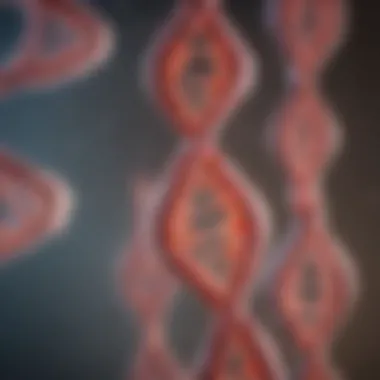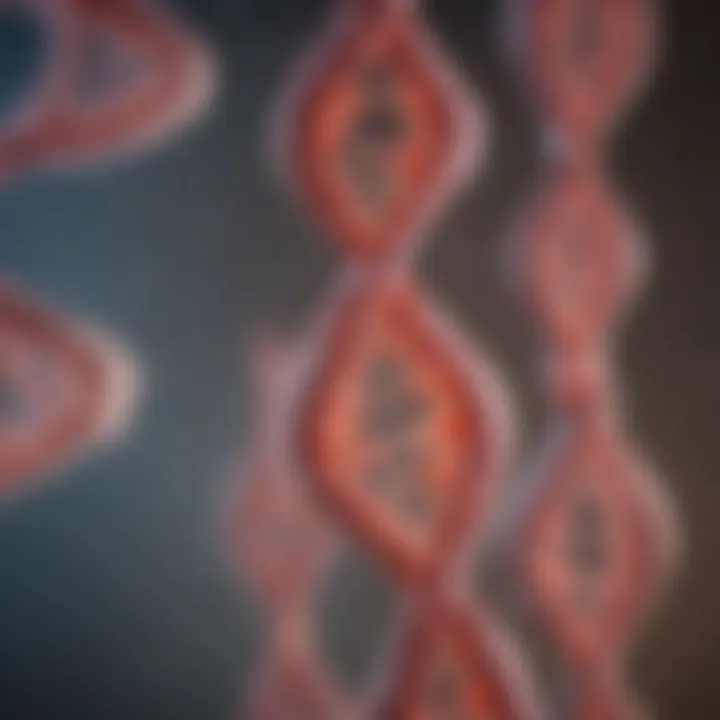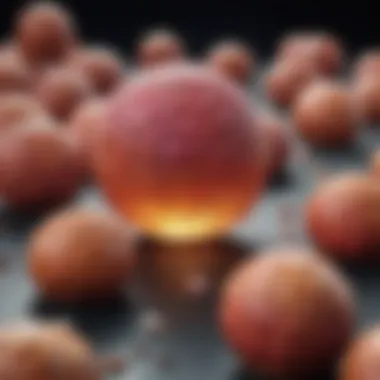Understanding Cell Differentiation: Mechanisms & Implications


Intro
Cell differentiation is a complex process where unspecialized cells evolve into specialized ones, each with distinct functions. This transformation plays a crucial role in the development of multicellular organisms. Understanding this process is essential for students, researchers, educators, and professionals in the fields of biology, medicine, and related sciences.
The study of cell differentiation encompasses various mechanisms, including genetic regulation, signaling pathways, and environmental influences. The implications of these mechanisms are vast, affecting development and disease, as well as presenting opportunities for clinical advancements.
Overview of Research Topic
Brief Background and Context
The concept of cell differentiation dates back to early embryological studies. Researchers observed how a single fertilized egg could develop into a complex organism composed of numerous specialized cell types. This differentiation is governed by a series of tightly regulated processes. Genes play a central role by determining how cells respond to internal and external signals. Moreover, environmental factors such as nutrient availability, temperature, and neighboring cells significantly impact differentiation outcomes.
Importance in Current Scientific Landscape
Currently, cell differentiation is a hot topic in regenerative medicine. Scientists are exploring how understanding these mechanisms could lead to breakthroughs in treating diseases. For instance, manipulating stem cells to differentiate into specific cell types holds the potential for repairing damaged tissues. Furthermore, insights into differentiation can provide clarity on certain diseases that arise from improper cell specialization.
"Understanding how cells transform into specialized types can illuminate both development processes and disease mechanisms."
Methodology
Research Design and Approach
Research into cell differentiation often employs various methodologies. Scientists utilize both in vitro and in vivo techniques to observe differentiation. In vitro studies allow for controlled experimentation on cell cultures, while in vivo studies investigate cell behavior within a living organism.
Data Collection Techniques
Data collection methods vary widely, including:
- Genomic sequencing to analyze gene expression during differentiation.
- Microscopy for visualizing morphological changes in cells.
- Flow cytometry to assess cell surface markers associated with specific cell types.
These techniques enable researchers to gather comprehensive data, ultimately leading to a deeper understanding of the differentiation process.
Preamble to Cell Differentiation
Cell differentiation is an essential concept within biology that describes how unspecialized cells develop into specialized cells that perform distinct functions. This process is crucial for multiple biological systems, affecting everything from tissue formation to responses to environmental signals. Understanding cell differentiation helps clarify the complexities of life and the intricacies of cellular functions.
In this article, we will explore various dimensions of cell differentiation, including its underlying mechanisms, implications for health and disease, and how these processes can be applied in practical settings such as regenerative medicine.
Definition of Cell Differentiation
Cell differentiation refers to the process by which a single, undifferentiated cell, like a stem cell, develops into a specialized cell type. This transformation involves changes in gene expression and cellular structure, allowing the cell to perform specific tasks that contribute to the overall function of tissues and organs. In essence, a differentiated cell acquires distinct characteristics that set it apart from its precursor cells.
The process of differentiation is not merely a switch. Rather, it encompasses a complicated interplay of genetic and environmental factors. Gene regulation and signaling pathways play pivotal roles in guiding a cell through its journey from a general state to a specialized identity. This means that each differentiating cell may undergo varied pathways, influenced by both intrinsic (internal) and extrinsic (external) factors.
Importance in Development and Function
Understanding cell differentiation is vital for several reasons. Firstly, it is essential for normal development. In multicellular organisms, differentiated cells form the building blocks of tissues, organs, and systems, each fulfilling unique roles. For example, muscle cells contract to enable movement, while neurons facilitate communication within the body.
Moreover, differentiation underpins the body’s ability to adapt and respond to changes in external conditions. Cells can modify their behaviors and functional capabilities based on stimuli they receive from their surroundings. This responsiveness is critical for processes such as healing and regeneration after injury.
However, deviations from normal differentiation patterns can lead to various disorders. For instance, cancer involves a breakdown in the regulation of differentiation, leading to the uncontrolled growth of cells that do not perform the functions they were meant to do. Understanding how differentiation works at a fundamental level can lead to significant advancements in treating such conditions, as well as in developing therapeutic strategies that harness cell specialization effectively.
"Cell differentiation is a key factor in understanding both normal physiology and pathological states."
The Process of Cell Differentiation
The process of cell differentiation is crucial to understanding how organisms develop and function. It encompasses the series of events that lead unspecialized cells to adopt distinct identities. This transformation is not random; rather, it follows a defined pathway influenced by both genetic and environmental factors. By exploring this topic, we reveal essential insights about organ development, tissue regeneration, and the overall maintenance of cellular homeostasis.
Stem Cells and Their Role
Stem cells are fundamental to the process of differentiation. These cells possess the unique ability to either self-renew or differentiate into specialized cell types. Two main categories of stem cells exist: embryonic and adult stem cells. Embryonic stem cells can give rise to all cell types in the body, while adult stem cells are typically limited to differentiating into cell types of their tissue of origin.
The ability of stem cells to differentiate is crucial in various biological processes. For instance, during embryogenesis, stem cells form the basis for organ and tissue development. Any dysfunction in this process can lead to congenital disorders. Furthermore, in adults, stem cells enable tissue repair and regeneration. In conditions like injury or disease, these cells mobilize to replace lost or damaged cells. Thus, understanding stem cell behavior is vital in regenerative medicine and therapies.
Signaling Pathways in Differentiation
Signaling pathways are integral to guiding cell differentiation. They comprise complex networks of interactions among various molecules within and outside the cell. Key pathways include the Notch, Wnt, and Hedgehog signaling pathways. Each pathway plays a specific role in controlling the fate of cells.


For example, the Notch signaling pathway influences cell fate decisions by mediating communication between adjacent cells. This interaction can trigger differentiation into specific cell types, such as neurons or muscle cells, depending on the context. On the other hand, Wnt signaling is pivotal in regulating embryonic development and stem cell maintenance. Disruptions in these pathways often lead to developmental abnormalities and diseases, underscoring their significance in differentiation.
Gene Expression and Regulation
Gene expression is a core component of cell differentiation. It involves turning specific genes on or off, shaping the cell's identity. This regulation occurs at multiple levels, including transcriptional and post-transcriptional modifications. Transcription factors, proteins that bind to specific DNA sequences, are essential for activating or repressing gene expression.
The interplay between transcription factors and epigenetic modifications dictates the differentiation trajectory of a cell. For instance, certain transcription factors can promote the expression of genes required for neuronal differentiation while inhibiting those associated with alternative lineages. Moreover, the epigenetic landscape—modifications to the DNA or associated proteins—affects accessibility to these genes, further guiding the differentiation process. As such, understanding gene regulation offers valuable insights into how cells specialize and function within broader biological frameworks.
In summary, the process of cell differentiation highlights the intricate balance between stem cell behavior, signaling pathways, and gene regulation. Each element interacts to shape the identities of cells, impacting development and organismal health.
Types of Cell Differentiation
Cell differentiation plays a vital role in the development and functionality of multicellular organisms. Understanding the types of cell differentiation is essential not only for understanding how cells develop and specialize but also for applying this knowledge in medicine and biology. Specific types provide insights into how cells diverge to form tissues and organs, contributing to the overall structure and function of an organism. One noteworthy aspect is that these differentiations are not merely fixed but can be influenced by various internal and external factors.
Lineage-Specific Differentiation
Lineage-specific differentiation refers to the process by which stem cells develop into their ultimate cell types, dictated by their lineage. This process is pivotal during embryonic development. For instance, a single zygote divides and gives rise to a myriad of cell types, each with distinct functions and characteristics.
The regulation of this process is often guided by a combination of genetic instructions and environmental signals. Specific transcription factors activate genes that promote differentiation into a certain lineage. For example, in hematopoiesis, multipotent stem cells in the bone marrow develop into various blood cell types, including red blood cells, white blood cells, and platelets.
Key points related to lineage-specific differentiation include:
- Predictability: The fate of a stem cell can often be predicted based on its lineage.
- Specialization: Each lineage results in cells with specialized functions, which enhances the efficiency and effectiveness of biological systems.
- Stability: Once a cell is differentiated along a specific lineage, it typically retains its identity, making it stable over time.
Plasticity in Cell Differentiation
Plasticity in cell differentiation challenges the notion of rigid cell fate. It refers to the ability of a differentiated cell to revert to a progenitor state or to change into another cell type entirely. This concept is crucial in understanding both development and healing processes. In some cases, differentiated cells can adopt new identities based on specific cues from their environment or signaling pathways.
For example, adult fibroblasts can be reprogrammed to become induced pluripotent stem cells (iPSCs). This plasticity has great implications for regenerative medicine, offering the potential to generate new tissues for repair.
Important aspects of plasticity include:
- Regenerative Capability: Cells exhibiting plasticity can participate in repair processes after injury.
- Adaptability: Cells can adjust to changing environments, which is important for homeostasis.
- Research Potential: Understanding plasticity can lead to advancements in cell therapy and cancer research.
In summary, the exploration of lineage-specific differentiation and plasticity provides vital information about cellular behavior, offering significant insights that could transform therapeutic approaches in medicine. These types enhance our understanding of the dynamic nature of cell differentiation.
Mechanisms Driving Differentiation
Cell differentiation is a complex biological process, and understanding the mechanisms that drive this process is crucial for many areas of research, including developmental biology, regenerative medicine, and disease treatment. Mechanisms of differentiation encompass both intrinsic and extrinsic factors, which work together to dictate cell fate. By examining these mechanisms, researchers can better comprehend how cells transition from a homogeneous state to specialized functions necessary for development and maintaining homeostasis in the body. These insights are essential for devising effective therapeutic interventions, especially in conditions like cancer and degenerative diseases.
Intrinsic Factors and Transcription Factors
Intrinsic factors are inherent to the cell itself. One of the most critical intrinsic factors is the group of proteins known as transcription factors. These proteins bind to specific DNA sequences, regulating the transcription of genes. Transcription factors serve as the primary regulators of gene expression, instructing the cell on which genes to activate or suppress during differentiation.
Key considerations regarding intrinsic factors include:
- Various transcription factors can act as activators or repressors. Their balance affects the outcome of differentiation.
- Specific combinations of transcription factors can lead to distinct cell types. For example, the factors Oct4, Sox2, and Nanog are vital in maintaining the pluripotent state of stem cells.
- Mutations in transcription factor genes may result in differentiation abnormalities. Such defects are often linked to developmental disorders and cancers.
By understanding how intrinsic factors function, researchers can manipulate these pathways. This manipulation may promote specific cell types or renew the capacity of cells for self-renewal.
Extrinsic Factors: Microenvironment and Signals
Extrinsic factors are external to the cell and include various signals and the physical microenvironment surrounding the cells. These factors play a significant role in determining how cells differentiate. The microenvironment provides the necessary cues for cells to respond and adapt, influencing their fate appropriately.
Examples of extrinsic factors include:
- Growth factors: These signaling molecules promote cell proliferation and influence which genes are expressed. For instance, fibroblast growth factors (FGFs) are crucial in numerous developmental processes.
- Cell interactions: Adjacent cells can release signals that impact neighboring cells, determining their differentiation outcomes through direct contact or soluble factors.
- Physical cues: Mechanical forces and substrate properties can also influence differentiation. Stem cells, for example, can respond to the stiffness of the surrounding matrix, which may guide them toward specific lineages.
Understanding how extrinsic factors guide cellular behavior is essential for tissue engineering and regenerative medicine. Researchers can recreated environments that support desired cell types for therapeutic applications.
"The interplay between intrinsic and extrinsic factors highlights the sophisticated nature of cell differentiation, emphasizing that both internal genetic programs and external stimuli are integral to achieving specialized functions.”
Cell Differentiation in Development
Cell differentiation plays a crucial role in development, shaping the very fabric of organisms from a single fertilized egg to complex multicellular structures. This process is far from trivial; it directs how cells transform into specific types, determining their structure and function. Each differentiated cell contributes to the overall functionality of tissues and organs. Understanding cell differentiation is essential for grasping developmental biology, as it provides insights into how life forms are organized and how various systems operate cohesively.
The significance of studying cell differentiation in development can be highlighted through several elements such as:


- Role in Organogenesis: Differentiation is essential for organ development. For instance, the heart forms through the differentiation of mesodermal cells into cardiac muscle cells.
- Maintenance of Homeostasis: Proper differentiation ensures that tissues can maintain their functions throughout the life of the organism, enabling healing and regeneration when necessary.
- Foundation for Evolution: Understanding how cells differentiate gives insight into evolutionary processes, showcasing how simple life forms have diverged into complex organisms through modifications in cell fate determination.
As we dive into the subtopics of embryonic development and tissue formation, a deeper comprehension of how these processes unfold will reveal their intricate connections to overall development.
Embryonic Development and Cell Fate
Embryonic development represents the initial phase of life, where differentiation is most pronounced. After fertilization, a zygote undergoes rapid divisions, leading to a blastocyst, which contains pluripotent stem cells. These stem cells have the ability to develop into any cell type, a property known as pluripotency.
During this stage, various signaling pathways guide these cells towards specific fates. For instance, factors from the surrounding environment can dictate whether a cell becomes part of the nervous system or a muscle. The intricate balance of these signals influences gene expression, effectively steering cellular behavior.
Assessment of cell fate in embryonic development can be summarized as follows:
- Initial Cell Divisions: During cleavage, the zygote divides into smaller cells without growth.
- Formation of Germ Layers: The inner cell mass of the blastocyst forms three distinct germ layers: ectoderm, mesoderm, and endoderm, each giving rise to different tissues and organs.
- Specialized Cell Types: As development progresses, cells receive signals that promote the expression of specific genes, allowing further specialization.
In summary, the embryonic stage is a foundational period where the future identity and role of cells are established, emphasizing the importance of effective signaling and gene regulation.
Differentiation in Tissue Formation
Tissue formation is the outcome of coordinated differentiation processes that result in the organization of various cell types into functional units. Differential gene expression creates a diverse array of cell types, each tailored for specific functions within tissues.
This process highlights several critical aspects of differentiation in tissue formation:
- Cellular Interaction: Cells within a tissue must communicate effectively to coordinate their functions. This interaction is facilitated by signaling molecules and extracellular matrix components, which help maintain tissue integrity.
- Pathways Influencing Differentiation: Various biochemical pathways play a role in determining how stem cells and progenitor cells differentiate into adult cell types. The Notch, Wnt, and BMP pathways, among others, have been identified as crucial in this process.
- Plasticity in Tissues: Although cells become specialized, some retain a degree of plasticity. This ability can sometimes lead to regenerative outcomes when tissues experience damage, further attesting to the significance of differentiation in maintaining tissue health.
In summary, understanding differentiation in tissue formation not only sheds light on normal development but also on potential therapeutic strategies for conditions such as degenerative diseases and injuries.
"Effective cell differentiation is essential for proper tissue formation and function. As research progresses, the potential for innovative treatments continues to grow."
Cell Differentiation and Disease
Cell differentiation plays a crucial role in understanding various diseases, particularly in how cellular abnormalities can lead to pathologies. This section explores the relationship between cell differentiation and disease, focusing on two main areas: tumorigenesis and stem cell disorders. The implications of cell differentiation extend beyond developmental biology into the realms of pathology and therapeutic innovations. Understanding these connections is essential for researchers, educators, and clinicians alike, as it provides insight into potential interventions and treatments.
Tumorigenesis and Cancer Cell Differentiation
Tumorigenesis refers to the process of forming tumors, often as a result of abnormal cell differentiation. In a healthy state, cells differentiate into specific types that fulfill appropriate functions. However, in cancer, this process can become dysregulated. Cancer cells may exhibit a loss of differentiation or an inappropriate type of differentiation, which often leads to aggressive growth and metastasis.
Key factors contributing to irregular cancer cell differentiation include:
- Genetic Mutations: Certain mutations can hinder the differentiation process, leading to uncontrolled proliferation of cells.
- Epigenetic Changes: In some instances, modifications to the genome that do not affect the DNA sequence itself can alter cell identity and function.
- Microenvironment Factors: The surrounding tissue can also influence the differentiation of cancer cells. Factors such as inflammation and hypoxia can create conditions that favor malignancy.
Understanding the nuances of cancer cell differentiation can guide therapies. For instance, differentiating agents, which promote the maturation of cancer cells, may allow for better treatment outcomes. Scientists strive to uncover the signaling pathways involved in this process to identify potential therapeutic targets.
"By studying how cells differentiate into cancerous forms, we can better understand how to revert them to a more benign state."
Stem Cell Disorders and Differentiation Defects
Stem cell disorders are another critical area of interest regarding cell differentiation. These disorders arise when the normal processes of cell differentiation are disrupted, leading to a range of health issues. Conditions such as aplastic anemia or certain types of immune deficiencies stem from the failure of stem cells to properly differentiate into blood cells or immune cells.
Some considerations in understanding stem cell disorders include:
- Defective Signaling Pathways: Many stem cell disorders result from abnormal signaling that affects how stem cells differentiate. This abnormality can arise from mutations or environmental cues.
- Clonal Expansion of Stem Cells: In some cases, a single population of stem cells can expand uncontrollably, producing dysfunctional cells. This is often observed in various blood cancers.
- Therapeutic Challenges: Understanding the underlying mechanisms driving differentiation defects is crucial for developing effective stem cell therapies. Approaches such as gene therapy or pharmacological interventions are under investigation to rectify these differentiation issues.
Understanding the mechanisms that underlie differentiation defects can assist in creating more effective treatments. Researchers aim to establish methods to correct these defects, which could lead to better health outcomes for affected individuals.
Applications of Differentiation Research
The study of cell differentiation holds significant potential for a wide array of applications that can transform fields such as medicine and biology. Understanding how cells differentiate contributes to better therapeutic strategies, particularly in regenerative medicine. By grasping the intricacies of this process, researchers can develop novel methods to treat diseases and injuries. Key areas of application include regenerative medicine, disease modeling, and drug discovery. These areas highlight the interconnectedness of differentiation research with clinical and practical outcomes.
Regenerative Medicine and Therapeutics
Regenerative medicine relies heavily on the principles of cell differentiation. The goal is to restore function to damaged tissues or organs by promoting the regeneration of specialized cells. For instance, techniques like stem cell therapy utilize undifferentiated cells that can develop into specific cell types needed for repair.
Therapies targeting conditions such as spinal cord injuries or heart disease show promise through differentiation manipulation. By understanding how to guide the differentiation process, scientists can potentially create effective treatments.
Some key points to consider include:
- Stem Cell Applications: Stem cell technology allows for the cultivation of cells that can become specific cell types, such as neurons or cardiomyocytes, supporting tissue repair.
- Tissue Engineering: Creating scaffolds for cells to grow can enhance the development of viable tissues for transplantation.
- Personalized Therapies: Advances in differentiation research could lead to therapies that are tailored to an individual’s cellular environment, optimizing treatment efficacy.


"Regenerative medicine offers hope for diseases that currently have limited treatment options, showing the essential role of cell differentiation research."
Disease Modeling and Drug Discovery
Cell differentiation also plays a crucial role in disease modeling and drug discovery. By using differentiated cells that mirror specific diseases, researchers can gain insights into disease mechanisms and identify potential therapeutic targets. This approach significantly enhances the understanding of the biological processes leading to conditions such as Alzheimer’s Disease and diabetes.
The significance of this research area includes:
- Model Systems: Differentiated cells can serve as models to study disease progression and response to treatments, providing more relevant data than traditional models.
- Compound Screening: Using differentiated cells allows for high-throughput screening of pharmacological compounds to identify effective drugs.
- Toxicity Testing: Testing the effects of new drugs on differentiated cells helps assess their safety and efficacy.
Ethical Considerations in Cell Differentiation Research
The ethical considerations surrounding cell differentiation research are crucial in guiding the scientific community's approach toward these studies. This discussion touches on both the moral implications and the responsibilities that accompany research into stem cells and genetic manipulation. Such considerations shape public perception, inform policy, and drive regulations. Understanding these issues is necessary for ensuring that advancements in the field are made responsibly and ethically.
Stem Cell Research Ethics
Stem cell research has long been a subject of ethical debate. Stem cells offer significant potential in regenerative medicine and tissue engineering. More specifically, human embryonic stem cells provide capabilities that are not possible with adult stem cells. However, obtaining these cells often involves the destruction of embryos, raising moral questions about the beginning of human life.
Researchers must navigate this ethical landscape with care. Important issues include:
- Source of Stem Cells: The distinction between embryonic and adult stem cells creates different ethical concerns. Adult stem cells can be sourced from tissues without harm, while embryonic stem cells involve ethical dilemmas regarding consent and the rights of an embryo.
- Informed Consent: Individuals contributing to stem cell research must give informed consent, understanding how their cells might be used and the potential risks involved. This is essential for maintaining ethical standards in the research community.
- Potential for Exploitation: There is a risk of vulnerable populations being exploited for stem cell donations. Ethical frameworks need to address how to protect these individuals while advancing science.
The benefits of responsible stem cell research can be profound, leading to breakthroughs in treating serious conditions, yet careful consideration is necessary to honor both ethical obligations and societal values.
Implications of Genetic Manipulation
The advancement of genetic manipulation techniques, such as CRISPR-Cas9, raises significant ethical questions about the future of cell differentiation research. While precise gene editing holds incredible promise for correcting genetic disorders, it also presents a host of implications that must be considered.
Key implications include:
- Potential for Off-Target Effects: Genetic manipulation is not foolproof. There is a risk of unintended modifications leading to unforeseen consequences, which raises concerns about safety and efficacy in treatments.
- Eugenics and Genetic Privacy: There are worries that genetic manipulation could lead to eugenics practices. The ability to select traits in embryos could create ethical challenges surrounding the desirability of traits, possibly exacerbating existing social inequalities.
- Long-Term Consequences: Manipulating genetic material can have long-lasting effects on future generations. Ethical considerations must address whether it is right to make decisions that can impact not only the present population but also future descendants.
- Regulatory Oversight: As technologies develop, regulatory frameworks must evolve to ensure responsible use of genetic manipulation techniques. This includes oversight of research practices and the ultimate applications in clinical settings.
"The intersection of ethics and scientific discovery in cell differentiation requires ongoing dialogue and careful regulation to ensure responsible advancements that benefit humanity."
As we proceed into the future of cell differentiation research, it remains imperative to balance innovation with ethical responsibility. Through rigorous examination of these considerations, researchers can pursue advancements that not only enhance science but also respect the values of society.
Future Directions in Cell Differentiation Research
Future directions in cell differentiation research hold immense significance. Understanding these directions allows scientists to explore potential therapies and improves knowledge of fundamental biological processes. The advancements in this field can drive innovation across medicine, particularly in regenerative therapies and personalized healthcare. Such developments can ultimately enhance patient outcomes and provide more effective treatment strategies.
Emerging Technologies and Techniques
Emerging technologies play a vital role in cell differentiation research. With advancements in technology, researchers can investigate cellular processes at an unprecedented scale and resolution. Techniques like single-cell RNA sequencing provide insights into gene expression profiles at the level of individual cells. This leads to a greater understanding of how differentiation occurs within complex tissues.
Another key technology is CRISPR-Cas9 gene editing, which enables precise modifications to the genome. This can be used to elucidate the role of specific genes in differentiation processes. Moreover, 3D culture systems and organoids allow researchers to study differentiation in more physiologically relevant contexts. These models replicate the microenvironment that cells experience in vivo, offering insights into how cells respond to various signals.
"The intersection of technology and biology continues to propel cell differentiation research into new realms, uncovering mysteries that were once beyond reach."
Towards Personalized Medicine
Personalized medicine is a future focus, aligning treatment approaches with individual patient characteristics. Cell differentiation research is poised to contribute significantly here. By understanding how specific cells differentiate in response to treatments, researchers can tailor therapies suited to individual genetic makeups. For instance, studying how different stem cells can be induced to differentiate into specific cell types might help devise personalized regenerative therapies. The goal is to improve the efficacy and reduce side effects of treatments by utilizing each patient's unique biological profiles.
In summary, the future directions in cell differentiation research promise profound advancements in medical science. Emerging technologies and the shift towards personalized medicine will likely lead to more effective strategies for managing diseases and improving overall health.
Integrating these innovations into clinical applications remains a priority, enabling breakthroughs that can change lives.
End
Cell differentiation is a critical process that influences many aspects of biology and medicine. Understanding the complexities of how cells transform from unspecialized to specialized states offers insight into normal development as well as pathological conditions. This article has explored various mechanisms involved in cell differentiation, detailing the intrinsic and extrinsic factors that impact this process. The role of gene expression, coupled with signaling pathways and environmental cues, emerges as a key theme throughout the discussions.
Summarizing Key Insights
To encapsulate the main points covered:
- Cell Differentiation Definition: Differentiation refers to how cells develop distinct functions, making them part of specific tissues or organs.
- Significance in Development: Differentiation is essential for embryonic development and the maintenance of homeostasis in mature organisms.
- Disease Implications: Disruptions in the differentiation process can lead to various diseases, such as cancer and stem cell disorders.
- Research Applications: Advances in differentiation research have far-reaching implications in regenerative medicine and therapeutic strategies.
Each of these insights emphasizes the intricate balance between genetic programming and environmental influences, highlighting how delicate changes can lead to significant biological outcomes.
The Importance of Continued Research
Continued exploration in cell differentiation is vital for multiple reasons:
- Innovative Therapies: Research could lead to the development of novel approaches in regenerative medicine, which aims to restore damaged tissues or organs.
- Understanding Diseases: Investigating differentiation pathways can reveal the mechanisms of various diseases, aiding in early diagnosis and treatment.
- Stem Cell Potential: As we learn more about stem cells and their differentiation, potential for personalized medicine emerges, offering tailored treatments for patients.
The future of medicine may hinge on our ability to understand and manipulate cell differentiation.



